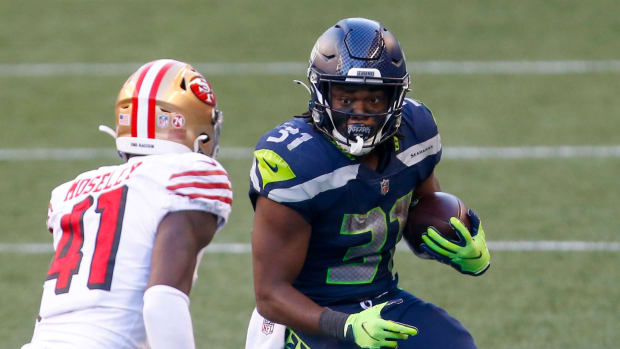Seahawks All-Time Undrafted Team: Offense
Over the past decade with general manager John Schneider and coach Pete Carroll running the show, the Seahawks have earned a reputation as one of the NFL's best organizations at mining undrafted talent.
But even before the arrival of Carroll and Schneider, Seattle had ample success finding undrafted stars throughout it's history, including having two notable undrafted players in the franchise's Ring of Honor.
Entering their 45th season of play in the NFL, which offensive players make the cut on our all-time Seahawks undrafted squad?
Quarterback: Dave Krieg
Honorable Mention: Jim Zorn
Not many teams have one notable undrafted free agent quarterback in their franchise history, let alone two. But the Seahawks had a pair of undrafted signal callers who carved out long, successful careers as starters in Krieg and Zorn.
Zorn became Seattle's first quarterback during the inaugural 1976 campaign, starting 100 games in nine seasons with the organization. Though he threw more interceptions than touchdowns shouldering the load for an expansion team that lacked talent, he passed for over 20,000 yards, rushed for over 1,400 yards, and garnered Second-Team All-Pro honors in 1978.
Krieg, who starred for tiny Milton College in Wisconsin, initially made the team as a third-string quarterback in 1980. He eventually took the reins from Zorn in 1983, setting then-franchise records for passing yards (26,132) and passing touchdowns (195) while earning three Pro Bowl selections in 12 seasons with Seattle. He led the team to its first AFC Championship Game appearance in 1983 and started seven total playoff games.
Running Back: Thomas Rawls
Though his career never panned out as expected, Rawls easily tops the list of best undrafted ball carriers in Seahawks history thanks to a sensational rookie season. Replacing an injured Marshawn Lynch, the former Central Michigan standout bulldozed through defenders for 830 rushing yards and four touchdowns in 13 games, averaging a league-best 5.6 yards per carry.
Fullback: Mack Strong
Honorable Mention: Leonard Weaver
Strong's impact went beyond the box score, as he didn't touch the football often but made substantial contributions for Seattle's offense as a dominant lead blocker out of the backfield. In 14 seasons with the franchise, he helped pave the way for three different running backs to surpass the 1,000-yard mark, made two Pro Bowls, and earned a First-Team All-Pro selection in 2005.
Once Strong was forced to retire due to an injury, Weaver proved himself a capable replacement who was dangerous with the football in his hands. A former tight end at Carson Newman College, he showed off his soft hands with 60 receptions for 547 yards in 46 games for the Seahawks.
Receivers: Doug Baldwin, Jermaine Kearse
Honorable Mention: James McKnight
If there's an undrafted offensive MVP for the Seahawks, Baldwin deserves strong consideration. He immediately became a factor as a rookie out of Stanford, leading Seattle in receptions and receiving yards. He eventually became the first Seahawks receiver since Bobby Engram to surpass 1,000 yards, doing it two consecutive seasons in 2015 and 2016. Earning two Pro Bowl nods, the savvy route runner finished his eight-year career with 6,563 receiving yards and 49 touchdowns.
After barely playing for Seattle as a rookie, Kearse caught 150 passes over the next four seasons, providing a valuable complement to Baldwin. He made several iconic catches in the postseason for the Seahawks as well, including the game-winning touchdown grab to finish off a stunning comeback win over the Packers in the 2014 NFC Championship Game.
A bit of a late bloomer, McKnight caught just eight passes in his first three seasons with the Seahawks. But he broke out in a major way in 1997, catching 34 passes for 687 yards and a league-best 18.7 yards per reception. He nearly got to the 1,000-yard mark two years later with the Cowboys.
Tight End: Mike Tice
Primarily known for his blocking, Tice only caught 92 passes in 10 seasons with the Seahawks. But his value shouldn't be understated, as he helped create running lanes for Curt Warner throughout the 1980s, helping him rush for over 1,000 yards four times. He also played in seven playoff games during the franchise's first taste of success.
Offensive Line: Garry Gilliam, Bryan Millard, Patrick Lewis, Alvin Bailey, George Fant
Gilliam's claim to fame was catching a touchdown on a fake field goal from punter Jon Ryan in the 2014 NFC Championship Game. However, the ex-Penn State tight end found his way into the starting lineup at right tackle for two seasons in Seattle, starting a grand total of 30 games and suiting up for six playoff games as well.
As the MVP of this undrafted offensive line, Millard signed with Seattle in 1984 and eventually became a key cog for several playoff teams. He became the full-time starting right guard in 1986 and played in all 16 regular season games during four of his six seasons as a starter, earning UPI Second-Team All-NFL recognition in 1988.
Lewis didn't last too long in the league, but at one point, he provided much-needed stability at center for Seattle after trading away Max Unger before the 2015 season. Replacing Drew Nowak midway through the season, he started nine regular season games and remained the starter heading into the playoffs.
Though he never became a full-time starter like Seattle hoped he would, Bailey played significant snaps as a sixth offensive lineman during the team's run to a second straight Super Bowl appearance in 2014. He also started in the comeback victory over Green Bay in place of an injured Justin Britt.
Not all of Fant's 24 starts with the Seahawks happened at left or right tackle, as he saw considerable action as a tight end the last two years. But he's one of the best success stories you'll find evolving from a college basketball player into a starting-caliber offensive lineman and may have been the team's long-term answer protecting Russell Wilson's blind side if he didn't tear his ACL in 2017.




